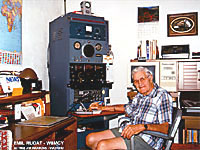Obituary From New Jersey Herald
STANHOPE — Friends remembered a Stanhope man who died in a motorcycle accident in Hope Township
Saturday as a perpetually pleasant person who always had a smile on his face.
According to state police, Peter Floro, 65, was driving a 1986 Harley Davidson southbound on Route 521 at about
2 p.m. Saturday when he hit a curb on the eastbound ramp for Interstate 80 and was thrown from the motorcycle.
Responders to the scene attempted to revive Floro using CPR but proved unsuccessful. Floro later died at Hackettstown
Regional Medical Center.
Blairstown First Aid Squad, St. Clare's Advanced Life Support and the Hope Fire Department responded to the crash.
Floro, a Hackensack native, lived in Sussex County for 38 years. He was an electrical engineer with General Dynamics
for 35 years until his retirement in 2007, at which point he became a consultant for Whippany-based David Ross
Group. Floro is survived by his wife of 40 years, Mary; his son, Stephen Floro, of Byram; mother Sarah Floro, of
Fair Lawn; and brother Paul Floro, of Tuscon, Ariz.
Floro was an avid fisherman and longtime member of the Sussex County Amateur Radio Club, in which he operated under
the call sign "WA2FCF."
"We lost a bright light when we lost Pete," said Walter Murphy, the treasurer of the Amateur Radio Club,
who knew Floro for more than 30 years. "Everyone got along with him. I never saw him frown. It was a shock
to lose him this way."
Murphy said Floro was always helping new members of the club understand the ins and outs of radio operation.
Dawn Payne, a former club president, secretary and Executive Committee member, described Floro as a "terrific
mentor" who helped get her up to speed after she joined the club in 1991. Payne said that, with Floro's aid,
she made her first-ever amateur radio contact, or QSO. Floro also lent her a radio rig until she could buy her
own, she said.
Dan Carter, current secretary of the Amateur Radio Club, remembered Floro as a "great, down-to-earth guy"
who never spoke an angry word about anyone and said Floro especially enjoyed the club's "Field Day" events.
In radio parlance, Murphy said, operators refer to fallen comrades as "silent kings," meaning they have
gone off the airwaves.
"He will be missed by a lot of people," Murphy said.
|


